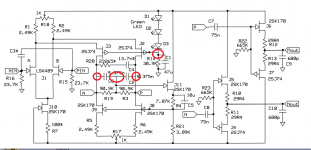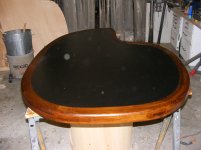Challenge accepted 😎.Max/Dan, Let us know when you prove 0.0000001% (That's 1 billionth, -180 dB if you will) of what you claim in your long diatribe above. I'll be thrilled for your Nobel Prize. Until then, please put up or shut up.
Hmmm, I don't understand where I can be accused of this.diatribe
[dahy-uh-trahyb]
See more synonyms for diatribe on Thesaurus.com
noun
a bitter, sharply abusive denunciation, attack, or criticism:
Dan.
He has it built.
I had my modified versions simmed, and built.
A simplified universal differential or single ended phono preamp
Patrick

I was referring to the connections on the schematic....perhaps they don't matter to the sim.
Dan.
I guess Scott hasn't it simmed yet.
Dan.
I have, it certainly works!
I love that common mode servo; You could say it creates a sort of virtual ground between the 90.9K resistors. You could call them I/V resistors.
-Alex
View attachment 701841
I was referring to the connections on the schematic....perhaps they don't matter to the sim.
Dan.
Oh, ok.
The circuit is self explanatory even without those missing dots I think.
It is a very clever circuit based on current conveyor, not unlike the Blowtorch.
The signal current is generated by the front end diff pair.
And the entire R-C network can be considered as an IV-impedance converter with RIAA compensation.
But the most intelligent bit is the common mode servo.
It acts full band with no LP filtering referenced to Gnd.
If you add a Gnd referenced LP filter, the single ended outputs actually have more distortion.
I tried many different variants in Spice and in the end use a slightly different CM servo which has much better PSRR.
Requires one extra P-devices (I used PNP in my build) and a couple more resistors.
Patrick
It is a very clever circuit based on current conveyor, not unlike the Blowtorch.
The signal current is generated by the front end diff pair.
And the entire R-C network can be considered as an IV-impedance converter with RIAA compensation.
But the most intelligent bit is the common mode servo.
It acts full band with no LP filtering referenced to Gnd.
If you add a Gnd referenced LP filter, the single ended outputs actually have more distortion.
I tried many different variants in Spice and in the end use a slightly different CM servo which has much better PSRR.
Requires one extra P-devices (I used PNP in my build) and a couple more resistors.
Patrick
Hi Richard,
What's 'funky' with NJM2043 ?
Good old Tech support as it is a current model. I told him what I wanted to do and why.... he couldn't send me schematic for current model but found on the schematic the input to the power amp and went back to the feed to it... a funky opamp -- ...2043 type. And then sent me photo of where it is on pcb. and pin number etc. Thats all I need.
I hate working with smd parts.
-Richard
What's 'funky' with NJM2043 ?
They were just joking about the missing dots.The circuit is self explanatory even without those missing dots I think.
On the topic of vinyl, I bet this engineer has mastered some of your favorite records. He is a legend in the business and very trusted.
I liked this short interview he gave, he looks somewhat grumpy getting ready to start his day when a clueless interviewer came to bother him. Then he opens up and gives quite technical information.
YouTube
View attachment 701841
I was referring to the connections on the schematic....perhaps they don't matter to the sim.
That is not a sim tool, I'm used to the artifacts of ExpressPCB. Patrick posted where the original plots are so I won't repeat them, but there is an RIAA response plot of the finished circuit. Jan also has the files on the Linear Audio site to confirm RIAA conformance using just a sound card. Patrick is right about improving PSRR, but I use batteries for mine.
It measures and sounds fine to me, I even used nothing but NOS TRW PS caps (hence the strange values). Patrick has posted several sets of values for RIAA networks with off the shelf parts.
Last edited:
We are hearing things that they can´t believe we´re hearing
We can point out things like the differences in digital copies and so forth, and they´ll swear they can´t hear the difference but we pick it out every time
I find that this was too vague a statement, he should have given more information about this comparison.
Thanks
-Alex
That is not a sim tool, I'm used to the artifacts of ExpressPCB. Patrick posted where the original plots are so I won't repeat them, but there is an RIAA response plot of the finished circuit. Jan also has the files on the Linear Audio site to confirm RIAA conformance using just a sound card. Patrick is right about improving PSRR, but I use batteries for mine.
It measures and sounds fine to me, I even used nothing but NOS TRW PS caps (hence the strange values). Patrick has posted several sets of values for RIAA networks with off the shelf parts.
 .
.Dan.
I mentioned one of my projects was a bit of studio furniture. Here is the top getting ready to go into the paint booth!
Scott,
I wasn't kidding and am a bit surprised no one else commented on the schematic.
What now, no supplies marked, the phase is switched, no bypassing????
What now, no supplies marked, the phase is switched, no bypassing????
No, just no second pass at labeling the parts, so the part numbers reasonably follow where the parts are located, not when you though of them.
As to phase among many they refer to it as polarity, a term I do not like as I am not immortal.
Hmmm, I don't understand where I can be accused of this.
Dan.
Definition of diatribe
1 : a bitter and abusive speech or piece of writing
2 : ironic or satirical criticism
3 archaic : a prolonged discourse
Ironically, that's what I thought was the primary definition. Whoops. Learn something new!
No, just no second pass at labeling the parts, so the part numbers reasonably follow where the parts are located, not when you though of them.
As to phase among many they refer to it as polarity, a term I do not like as I am not immortal.
You got me on that one, I don't know anyone that does that unless they have OCD tendencies. Huge circuits are partitioned, typically a 100's section, 200's section and so on. They are in fact auto numbered by the software and going back over it is a needless waste of time IMO of course.
Hi Scott,
That is unless you added parts to a section. I just have the software auto-number the parts again. No wasted time to speak of. I'm using DipTrace these days.
-Chris
That is unless you added parts to a section. I just have the software auto-number the parts again. No wasted time to speak of. I'm using DipTrace these days.
-Chris
You got me on that one, I don't know anyone that does that unless they have OCD tendencies. Huge circuits are partitioned, typically a 100's section, 200's section and so on. They are in fact auto numbered by the software and going back over it is a needless waste of time IMO of course.
It is nice when you go back to do it again after time has passed and memories faded. I even like to put the name of the circuit on the PC card so when I find loose ones later I know what it was for.
Hi Scott,
That is unless you added parts to a section. I just have the software auto-number the parts again.
In this case there is no global removal/adding of part numbers. The software always picks the next missing one so AFAIK you have to do one at a time no matter what. I don't care in any case this makes no sense to me at all.
I even like to put the name of the circuit on the PC card so when I find loose ones later I know what it was for.
That is a good point, but the numbering does nothing for me, the schematic is visualized (for me) with no numbers or values at all.
- Status
- Not open for further replies.
- Home
- Member Areas
- The Lounge
- John Curl's Blowtorch preamplifier part III
